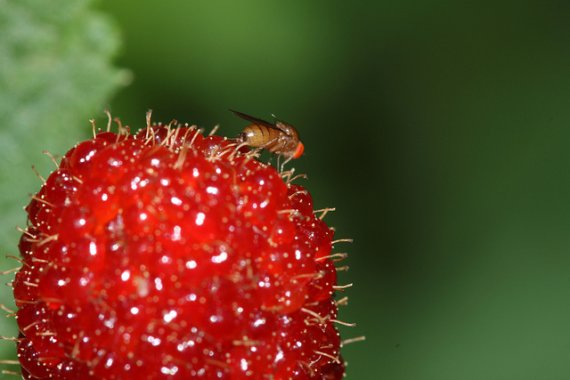The Netherlands already had loads of fruit flies but fortunately they gorge on rotting fruit; they don’t touch healthy strawberries, cherries or raspberries that are still on the plant. But the spotted wing drosophila (Drosophila suzukii) is different. The exotic fly has a strong ovipositor (egg-laying appendage) that easily lets it make a hole in unblemished fruit. Then it lays its eggs under the skin. When the larvae hatch, the fruit starts to rot and is no longer fit for sale.
The Asian fruit fly was first seen in Europe in 2008, says fruit researcher Herman Helsen. It spread in no time from Spain to the rest of Europe, reaching as far afield as Sweden. The spotted wing drosophila lays eggs ten times a year, says the Wageningen entomologist. ‘There are billions of the creatures in the Netherlands at the moment. You find them on every soft fruit bush.’ The spotted wing drosophila is not fussy. The flies hop from one ripe fruit to another, which enables their population to grow exponentially in the course of a fruit season. They can be found not just on fruit farms but also in our back gardens and allotments and in woods – anywhere where fruit is.
MOSQUITO NETS
What can we do? ‘We’ll never get rid of them,’ says Helsen emphatically. He mainly advises fruit growers on how to avoid the pest getting out of hand during the growing season. The key thing for the growers is to remove all the ripe fruit. ‘When you harvest the fruit, you remove the eggs from the farm. If you do that consistently, you won’t get an outbreak. Growers have to get rid of all the fruit, including the fruit that has fallen on the ground.’ A critical factor in this approach is that the fruit must be ripe for harvesting before the next generation of fruit flies emerges. That is the case for fruits that ripen quickly, such as strawberries and raspberries but not for cherries. So different measures are needed there. As Helsen does not yet know of any natural enemies the flies might have, he says we may need to use chemicals to combat the spotted wing drosophila. Another option is to use mosquito nets to protect cherry trees, but that would require a huge investment.
PPO Fruit in Randwijk is currently looking at an integrated pest control strategy in a Dutch consortium with fruit growers and auction houses. It is also participating in an EU project to learn more about the biology of the fruit fly and organic pest control.

